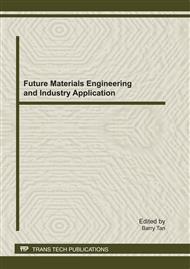[1]
Liu S, Cheng L, Exploitation actuality and expectation of polygonum cuspidatum's effective ingredients, Food Science and Technology, vol. 2(2), p.96-98, (2005).
Google Scholar
[2]
Meishiang J, Lining C, Udeani G, Cancer chem opreventive activity of resveratrol, a natural product derive from gapes, Science,vol. 275(1), p.218-220, (1997).
Google Scholar
[3]
Hisashi M, Hiroshi S, Toshio M, Phytoestrogens from the roots of Polygonum cuspidatum (polygonaceae):structure–requirement of hydroxyanthraquinones for estrogenic activity, Bioorganic and Medicinal Chemistry Letters, vol. 11(4), p.1839-1842, (2001).
DOI: 10.1016/s0960-894x(01)00318-3
Google Scholar
[4]
Cheol S P, Yonng C L, Jong D K, et al, Inhibitory effects of Polygonum cuspidatum water extract (PCWE) and its component resveratrol on acyl-coenzyme A-cholesterol acyltransferase activity for cholesteryl ester synthesis in HepG2 cells, Vascular Pharmacology, vol. 40(6), p.279-284, (2004).
DOI: 10.1016/j.vph.2004.01.003
Google Scholar
[5]
Wang S, Zheng Z, Weng Y, Angiogenesis and anti-angiogenesis activity of Chinese medicinal herbal extracts, Life Sciences, vol. 74(20), p.2467-2478, (2004).
DOI: 10.1016/j.lfs.2003.03.005
Google Scholar
[6]
Zhou J, Zhang H, Yang P, Li H, Determination of resveratrol glucoside and resveratrol in radix and rhizome of Polygonum cuspidatum yielded in Hanzhong Region, Chinese Traditional and Herbal Drugs, vol. 33(5), p.414-416, (2002).
Google Scholar
[7]
Wang Z, Luo Z M, Deng L W, The Pharmacological Mechanism and Synthesis of Resveratrol, Natural Product Research and Development,vol. 15(2), p.178-181, (2003).
Google Scholar
[8]
Wang T M, Wang X M, Recent Progress of Pharmacological Functions of Polydatin, Journal of Suzhou College,vol. 22(2), pp.114-116, (2007).
Google Scholar
[9]
Cao Y, Chen X X, Tang Y H, Xiang H, et al, Study on High Produce Resveratrol Material Filtration and Callus Abduction of Polygonum cuspidatum, Life Science Research, vol. 10(3), p.271-275, (2006).
Google Scholar
[10]
Yang P J, Li H N, Zhao H, Tissue culture and rapid propagation of Reynoutria japonica, Acta Botanica Boreali-occidentalia Sinica, vol. 23(12), p.2192-2195, (2003).
Google Scholar
[11]
Wen T, Liang L, Zeng Y, Yu X, Effect of different light intensity on Polygonum cuspidatum callus, China Journal of Chinese Materia Medica, vol. 32(13), p.1277-1280, (2007).
Google Scholar
[12]
Ou J Q, Chen X X, Ding L H, Cao Y, Callus Inducement and Resveratrol Formation of Polygonum cuspidatum, Journal of Central South Forestry University,vol. 26(3), p.24-27, (2006).
Google Scholar
[13]
Yi A Q, Tong F P, Song Q, et al, The tissue culture technology of Polygonum cuspidatum sieb et zucc, Hunan Forestry Science & Technology,vol. 34(1), p.10-12, (2007).
Google Scholar
[14]
Jiang S, Zhu R R, Jing S L, et al, Optimization of extraction of polydatin from Polygonum cuspidatum, Chinese Journal of New Drugs, vol. 17(22), p.1953-1956, (2008).
Google Scholar
[15]
Xu H L, Fu Y H, Gao P, Xu C J, Study on Extraction Process of Resveratrol in Polygonum cuspidatum, Lishizhen Medicine and Materia Medica Research,vol. 17(8), p.1424-1425, (2006).
Google Scholar
[16]
Xiang H H, Dai K J, Luo Q Z, Optimization of extraction process for resveratrol from Polygonum cuspidatum Sieb et Zucc after enyzmatic treatment, Journal of Central South University (Science and Technology) , vol. 39(4), p.700-704, (2008).
Google Scholar
[17]
Jun I, Suzuki, Growth dynamics of shoot height and foliage structure of a rhizomatous perennial herb,Plygonum cuspidatum, Annales Botany,vol. 73(6), p.629-638, (1994).
DOI: 10.1006/anbo.1994.1079
Google Scholar


